Just now
By Peter Shuttleworth, BBC News

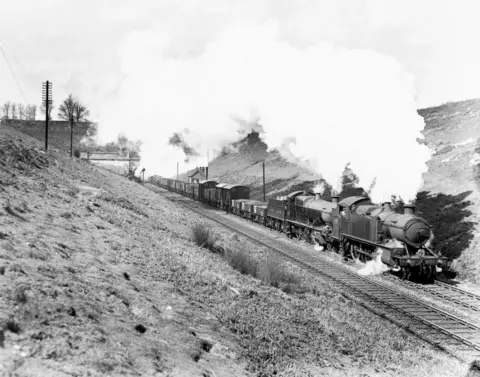 Getty Images
Getty Images
Now about 200 trains travel through the Severn Tunnel everyday so fast that the air pressure inside the tunnel would pop your ear drums
Its leaking water is in your beer, it's where an Oasis classic was born and where one of the first Scuba dives took place.
It's also one of the most hostile places to put a railway line.
More than 20 Olympics pools worth of water is pumped from the Severn Tunnel every single day - some of which is used in drinks such as Budweiser and Stella Artois, brewed just a few miles away.
You'd be forgiven for not knowing how hard it is to simply make your train trip happen when travelling between Wales and England, on this engineering marvel deep beneath the UK's longest river.
It was once the world's longest underwater tunnel, a structure that took 13 years to build by hand - using picks, shovels, drills and dynamite - almost 140 years ago.
It's a place where it feels like it's always drizzling - and it's that constant seepage of saltwater from the river above that makes it the most inhospitable environment to have a railway line.
How you maintain one of the oldest and longest river tunnels in the world
When it goes dark outside for three minutes and 40 seconds while cruising through the tunnel at 75mph (120km/h) on one of the UK's busiest rail routes, connecting London and Bristol with south Wales, most people are completely oblivious to the work that's been done to keep them moving.
It is the deepest part of the UK's 22,000 mile (35,000km) rail network, and where the railway track is replaced more than any other because of the hugely corrosive, saltwater atmosphere nearly 150ft (50m) below the sea level.
That's why the Severn Tunnel is currently shut for the longest time - other than when it was electrified a few years ago - since it opened in 1886.
Normally about 200 trains a day pass through the four-a-half mile (seven km) structure every day.
Not at the moment, though, as engineers have blocked it for 16 days until 19 July to renew the submerged south Wales-bound line, swapping all 66 rails, 10,800 sleepers and the 22,000 tonnes of ballast that support the track.


The Severn Tunnel is more than four miles long but just two-and-a-quarter are underwater
"With the water ingress, diesel fumes from trains and aggressive nature of the minerals in the tunnel, it attacks the rail, so every five years now we have to renew the track," said Brian Paynter of Network Rail.
"For the sleepers and ballast, they're replaced every 15 years. In the UK, it's probably the quickest we renew any rail because of the hostile environment."
Outside the Severn Tunnel, track is usually replaced every 25 to 30 years.
When was the Severn Tunnel built?

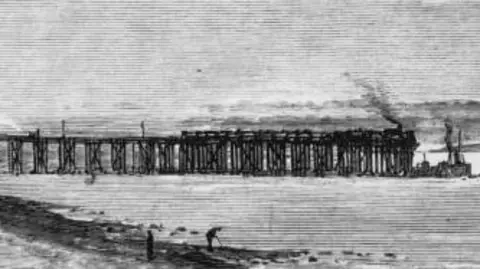 Getty Images
Getty Images
Before the Severn Tunnel, a steam ferry service crossed the estuary from England to Wales, which opened in 1863
Even though 76.4 million bricks - often 10 layers deep surrounded by 1m (3ft) of rock - hold back the tide from one of the most notorious stretches of water, the Severn still seeps through the tunnel lining.
Keeping the tunnel dry - below a fast-flowing river with the third highest tidal range in the world - has been a challenge since digging began beneath the Severn Estuary in 1873.
It was only the second tunnel attempted under water - but this was more than 13-times longer than the first, the 400m (1,300ft) long Thames Tunnel in London, which opened in 1843
There was no laser-guided radar equipment or tunnel boring machines to build this feat of engineering in Victorian times.
It was all blood, sweat and tears with a lot of geology and mathematics plus some trial and error.

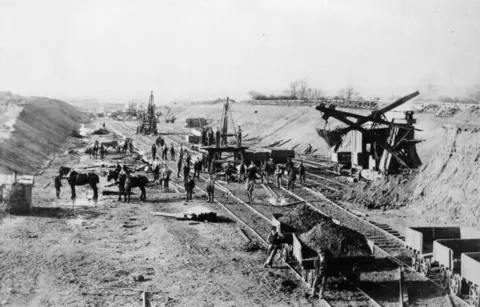 Getty Images
Getty Images
There were no machines and modern technology around when the Severn Tunnel was built, construction used more primative techniques
"Engineers were made of something else in those days," added Mr Paynter.
"I can only imagine how difficult it was, with no computers, no phones, no lasers, no sonar - they did an amazing job and 150 years later it's still going strong."
The tunnel and its approaches are about seven miles (11km) long so the line can dip almost 450ft below the lowest point of the Severn, but ensure the gradient is gentle enough for express trains to whizz through.
Work was arduous and slow, with pumps extracting any water - but disaster struck six years into the build, when diggers struck an underwater spring.
Scuba diving first during Severn Tunnel build

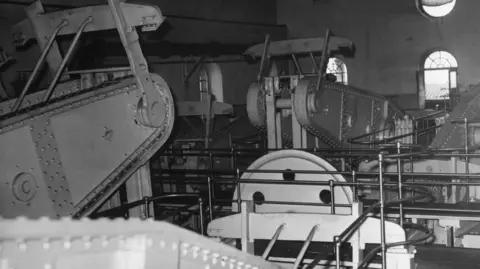 Getty Images
Getty Images
Massive pumps on the Welsh side of the Severn Tunnel have helped ensure the busiest rail link between England and Wales has remained open for almost 140 years
Workers were less than 119m (400ft ) from connecting the two tubes when the tunnel flooded for the first time in 1879.
Construction was delayed by more than a year and could only resume after Alexander Lambert undertook one of the first scuba dives in history, using Henry Fleuss' newly-developed self-contained rebreather apparatus, which enabled him to shut a watertight door.
The Great Western Railway's chief engineer Sir John Hawkshaw also ordered the spring to be sealed and realigned the tunnel's path lower to avoid more trouble.
Floodwater did penetrate the tunnel a few more times, most notably in 1883 and 1885, so engineers installed bigger, permanent pumps on the Welsh side.
Still, to this day, those enormous pumps work 24/7 to suck 20m gallons of water out of the tunnel every day - with some of it going in your pint.

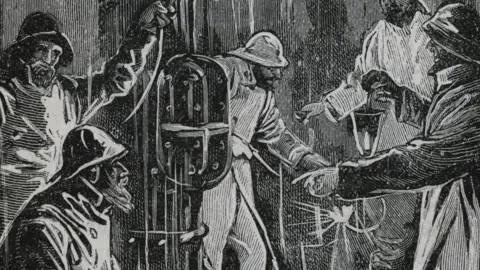 Getty Images
Getty Images
Pumping the water out of the Severn Tunnel has been one of the biggest engineering challenges since construction began in 1873
The tunnel cut the journey time between Bristol and south Wales by about an hour - and was the quickest way you could cross the estuary before the first Severn road bridge opened in 1966.
It was the longest underwater tunnel in the world until 1987 and, for more than 100 years, it was the longest mainline railway tunnel in the UK.
But to keep it operational and reducing delays is a mammoth task that needs constant attention - and each programme of work takes five years to plan and starts as soon as the previous cycle had ended.
Was an Oasis song written under the Severn Tunnel?

 Getty Images
Getty Images
Oasis did a lot of recording of their earlier albums in south Wales and songwriter Noel Gallagher wrote a song while waiting on a delayed train under the Severn Tunnel
Yet one delay under the tunnel in the 1990s gave Noel Gallagher time to write one of Oasis' most popular songs and a 1990s Britpop anthem.
Acquiesce, a fan favourite and an Oasis set list staple for 15 years, had its musical beginnings under the sea between England and Wales.
"I wrote that song on the train on the way to Loco Studios in south Wales for the Definitely Maybe sessions," Oasis song writer Noel Gallagher once said.
"I was on my own. I was stuck in the Severn Tunnel and I had my acoustic guitar. I was like 'pass me the guitar, what's that word Acquiesce mean?'"
The tunnel was shut for 10 days last year for track to be replaced, this year it is closed for 16 days for similar around-the-clock works that will cost about £10m.
Why the Severn Tunnel is closed in July?

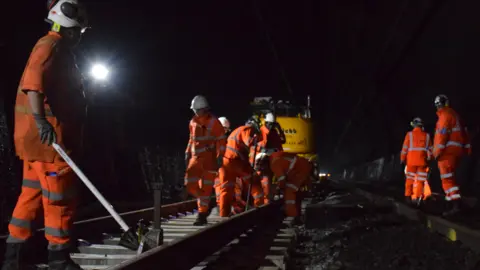 Network Rail
Network Rail
There will be almost 200 workers in the Severn Tunnel round the clock for 16 days replacing the track during July
Water-collecting drains have been added into the crown of the tunnel to minimise saltwater dripping on the tracks.
Ventilation fans have also been installed to create a constant breeze to help make the environment kinder to the steel track and electric wires.
Each of the 66 lengths of new railway track that will be installed this July is bigger than two football pitches at 215m (705ft) long and cost about £14,000 apiece.
Some 10,800 concrete sleepers, costing £90 each, will also be swapped.
"There are sceptics saying you're blocking the railway again," added Mr Paynter from Network Rail.
"But I'm doing it for the greater good to ensure a resilient and safer network. This is a temporary period of disruption, but if we don't replace the track, everything becomes life-expired. It's short pain for long gain."

 4 months ago
7
4 months ago
7















 English (US) ·
English (US) ·